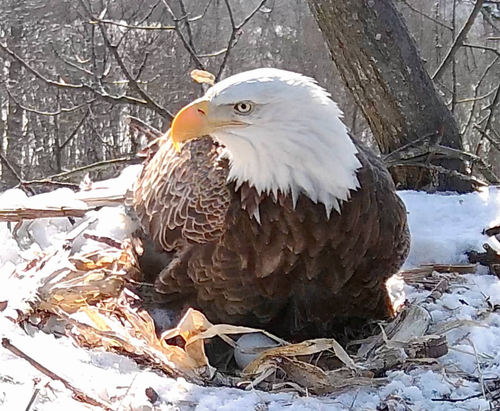Hanover Bald Eagle Blog # 6 - 2022
In partnership with Pennsylvania Game Commission and Comcast Business .
AT 2:09 PM ON SATURDAY, FEBRUARY 12TH, THE FIRST EGG WAS LAID! THE HANOVER EAGLES ARE OFFICIALLY PARENTS.

Many of you suspected the first egg would arrive this week and you were right! Just in time for Valentine’s Day, the Hanover couple has plenty to celebrate as they move into the next phase of the breeding season.
If the Hanover female is going to lay a second egg it should arrive before the 18th. That being said, there are always exceptions to the eagle calendar, and females don’t always lay two eggs. Bald eagle clutch sizes range from 1-3 eggs, with 2 being the most likely. Factors like food availability, the female’s health, and environmental conditions can influence clutch size as well as the viability of the eggs.
The female will do most of the incubating, with occasional reprieve from the male for a few hours at a time. If he takes too long to return to the nest, she may emit exuberant vocals that signal quite clearly “Get your butt over here!” Towards the end of the incubation stage the male will transition to providing for her full time while she sticks to the nest. Whichever parent is not incubating remains on guard, keeping a vigilant eye to the sky for potential intruders, nest usurpers, and/or predators. Bald eagles are top predators, but there are still a few wily egg eaters out there who will try their luck, including raccoons, crows, ravens, fishers and, unsurprisingly, great-horned owls.
The parents must keep the eggs at a toasty 105°F (41°C), hence the importance of the brood patch mentioned in Blog 5. A developing embryo is vulnerable to many dangers and requires constant care, especially during the first few days as it gains access to protein, water, and nutrients within the egg. This is a delicate process. The embryo must remain in the right position to receive resources from both the albumen (egg white) and the yolk. The Hanover parents turn and roll the egg to keep these internal processes in working order.
In the coming weeks, we may see the egg(s) left unattended for short periods of time. This is typical, and while the eggs are vulnerable to the elements if left alone for too long, these eagle parents have been around the block and are well attuned to the needs of their young. They will return.
We can expect the first egg to hatch approximately 35 days from time of laying, or around March 19th.
Congratulations to the Hanover eagles and welcome into the world little one. We can’t wait to meet you!
Sources
Birkhead, Ti (2017). The Most Perfect Thing. London, United Kingdom: Bloomsbury Publishing PLC.
Hancock, David. (2018). Eggs Incubation and Hatching. Hancock Wildlife Foundation. https://hancockwildlife.org/hancock-wildlife-reference/bald-eagle-biology/eggs-incubation-hatching/ ;

Written by Zoey Greenberg
RETURN TO HANOVER BALD EAGLE BLOGS
WATCH THE HANOVER BALD EAGLE LIVE CAMS
For over 20 years, HDOnTap has provided live streaming solutions to resorts, amusement parks, wildlife refuges and more. In addition to maintaining a network of over 400 live webcams, HDOnTap specializes in design and installation of remote, off-grid and otherwise challenging live streaming solutions. Contact press@hdontap.com for all media needs, including images and recordings.

